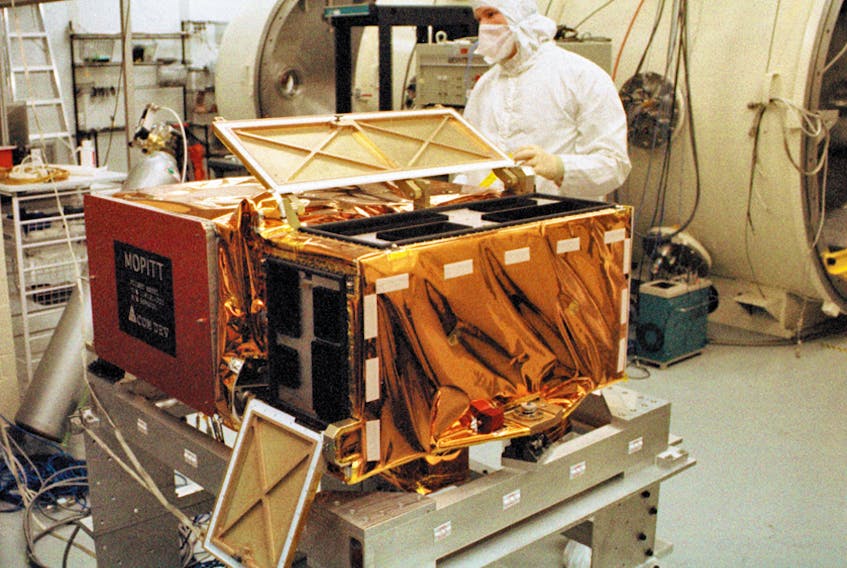When Jim Drummond and his colleagues first started to think about ways they could measure carbon monoxide levels in the lower atmosphere, he was doing his calculations on an IBM personal computer that ran at the stunning rate of eight megahertz.
A lot has changed since those days in the late 1980s - for instance computer speeds are now measured in the gigahertz range - but the carbon monoxide measurement project that grew out of those first conversations over 30 years ago is still going.
“It’s a very interesting road,” said Drummond, who recently retired from Dalhousie University’s department of physics and atmospheric science.
It will be 20 years on Wednesday since the carbon monoxide analysis sensor blasted off aboard NASA’s Terra satellite platform from Vandenberg Air Force Base in California on Dec. 18, 1999. Since that time, MOPITT (Measurements of Pollution in the Troposphere) has monitored C0 levels from an altitude of about 705 kilometres.
Drummond said he never imagined he’d be still talking about the project in 2019.
“This was supposed to be a five-year mission, like Star Trek,” he said with a chuckle in an interview Tuesday. “We thought that if we pushed we might get to seven years. The idea that (it would be) still going for 20, we hadn’t even thought of it.”

The notion of analyzing the troposphere’s C0 levels sprung from a casual conversation with his then-colleague atmospheric scientist John Gille in the cafeteria of the National Center for Atmospheric Research in Boulder, Colo., in 1987.
Drummond was on sabbatical from the University of Toronto so he had the time to write up a short paper on the idea, which eventually evolved into a major project funded and operated by the Canadian Space Agency.
Test facilities were built at the University of Toronto and by 1996 the instrument was mostly completed and ready to undergo testing. First in Canada, and then when integrated onto the Terra spacecraft at Valley Forge, Penn., the MOPITT instrument underwent a gruelling test schedule. It was finally ready for launch in 1999.
Once in space, the instrument revealed levels of carbon monoxide in the lower atmosphere that alarmed Drummond and his colleagues.
“The original idea when it started it out was measuring pollution,” he said. “It was a big issue because . . . we didn’t really know what was going on. When we saw the maps, when we saw what we were producing, the reaction was wow! We didn’t understand this before.”
Carbon monoxide is spewed into the atmosphere by wildfires and emissions from energy generation plants and motor vehicles.
In intense concentrations, such as that produced by a faulty heater in a house, C0 can be fatal for humans. The levels in the atmosphere are obviously spread out over a wide area but it’s still a form of pollution that must be monitored and controlled.
Drummond said it’s also helped scientists as they look for ways to track the levels of carbon dioxide, the greenhouse gas that has caused a climate emergency on our planet.
MOPITT has made more than 100,000 orbits as part of the Terra mission and 1.3 billion measurements resulting in more than 470 publications.
“And what we’re seeing that over the couple of decades, we’re seeing a small global reduction,” Drummond said. “Not a big one. . . . Some areas are doing better and some areas doing worse.”
The reason for the decline likely relates to stricter regulations on industrial emissions and burning restrictions that have led to fewer grass and forest fires.
But wildfires remain a huge problem in some parts of the world such as Africa, Indonesia and most recently Australia.
“The main global issue is to try and understand how the pollution and the C0 is produced and then figure out how you reduce that,” such as cities restricting vehicle use in downtown areas, Drummond said.
“In areas with a government that has the ability to do that, that’s important.”
The lessons learned from the project are helping scientists develop models that can forecast levels of carbon monoxide and carbon dioxide in the atmosphere.
Although MOPITT has outlasted its original past-due date by a long shot, the sensor likely doesn’t have many years left.
“Unfortunately we’re going to run out of fuel in the end of 2022," Drummond said.
The Canadian Space Agency has funded the operation since its implementation. Drummond didn't have a specific figure but said the amount the agency has spent hasn't exceeded $20 million. While the project has taken centre stage in his own career, he said it’s been a team effort involving many scientists over the years.
“It’s been enormously successful, it’s just amazing."









